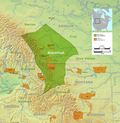Battle of the Belly River
| Battle of the Belly River | |||||||
|---|---|---|---|---|---|---|---|
| |||||||
| Belligerents | |||||||
| Blackfoot Confederacy | Cree | ||||||
| Commanders and leaders | |||||||
| Big Leg Black Eagle Heavy Shield Crow Eagle Bull Back Fat Button Chief | Big Bear Little Pine Little Mountain Piapot | ||||||
| Strength | |||||||
| 500-800 warriors | 500-800 warriors | ||||||
| Casualties and losses | |||||||
| 40 killed 50 wounded | 200-400 killed | ||||||
The Battle of the Belly River was the last major conflict between the Cree (the Iron Confederacy) and the Blackfoot Confederacy, and the last major battle between First Nations on Canadian soil.
The battle took place within the present limits of the city of Lethbridge on the banks of the Oldman River, which at the time of the battle, was called the Belly River. A devastating outbreak of smallpox had reduced the strength of the Blackfoot, and a Cree war party had come south in late October 1870 to take advantage of that weakness. An advance party of Crees had stumbled upon a Peigan camp and decided to attack instead of informing the main Cree body of their find.
The Blackfoot and the Cree were fighting to gain control of the Cypress Hills boundaries and in the fall of 1870 there was a battle between them called the "Battle of Belly River." Big Bear and Little Pine led the Cree’s and attacked a Blood First Nations camp. The next day, well armed Peigans entered the battle and defeated the Cree, approximately 200-400 Crees died in the battle. Eventually the Cree and Blackfoot negotiated peace and access to the Cypress hills.[1]
Soon word passed to other Blackfoot, Blood and Peigan camps in the immediate area, and warriors were sent to join battle. After several hours of trading shots, a Blackfoot party gained the high ground and made the Cree positions untenable. The retreat became a rout, and up to 300 Cree warriors were killed trying to make their escape.
Approximately a year after the battle, the Cree and Blackfoot made a formal peace. This was formalized by Crowfoot, a Blackfoot chief, ritually adopting Poundmaker, an up-and-coming Cree leader in 1873. Treaty No.7, between the Blackfoot Confederacy and the Crown, was signed in 1877. In 1906, the town of Lethbridge was founded near the battle site. The battle itself is commemorated in Indian Battle Park.
See also
References
- ^ Dodson, 14, quoted at https://web.archive.org/web/20160401180710/https://treaty6education.lskysd.ca/1870
External links
- The Shrine of Dreams
- v
- t
- e
| Blackfoot-speaking | |
|---|---|
| Later members |
|

| Reservations (US) |
|
|---|---|
| Reserves (Canada) |
- War with Shoshone (circa 1730s-1800s)
- 1775–1782 North American smallpox epidemic
- 1837–1838 smallpox epidemic
- Treaty of Fort Laramie (1851) (with USA)
- War against the Crow and Gros Ventre (circa 1861–1867)
- Treaty of Fort Laramie (1868) (with USA)
- Battle of the Belly River (against the Cree, 1870)
- Marias Massacre (by US Army, 1870)
- Peace with the Cree, circa 1871, (symbolized by Crowfoot's adoption of Poundmaker in 1873)
- US land annexation, migration to Canada (1874)
- Treaty 7 (with Canada, 1877)
- Starvation winter (1883–1884)
- Sweetgrass Hills Treaty (with USA, 1887)
 Category
Category Commons
Commons
49°41′38″N 112°51′40″W / 49.69391°N 112.86105°W / 49.69391; -112.86105 (Battle of the Belly River)
 | This First Nations in Canada-related article is a stub. You can help Wikipedia by expanding it. |
- v
- t
- e
  | This Canadian history article is a stub. You can help Wikipedia by expanding it. |
- v
- t
- e
 | This Canadian military history article is a stub. You can help Wikipedia by expanding it. |
- v
- t
- e
This Lethbridge-related article is a stub. You can help Wikipedia by expanding it. |
- v
- t
- e












